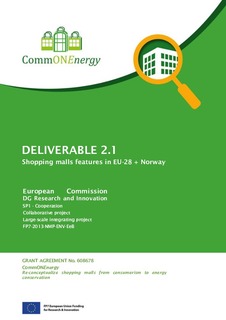| dc.description.abstract | The European wholesale and retail sector is the big marketplace of Europe, contributing with around 11% of the EU's GDP. Therefore, sustainability of the retail sector may significantly contribute to reaching the long - term environmental an d energy goals of the EU. Within the retail sector, shopping malls are of particular interest due to their structural complexity and multi - stakeholders decisional process, due to the high potential of energy savings and carbon emissions reduction, as well as due to their importance and influence in shopping tendencies and lifestyle.
CommONEnergy focuses on reducing the energy consumption in EU shopping malls by developing smart renovation strategies and solutions. The big challenge is to provide sustainabl e options that are also cost - effective with an acceptable payback period for this business sector. In order to gain an understanding of the current shopping mall building stock, this report investigates shopping malls features in the EU - 28 and Norway based on an extensive literature survey and on a broad and detailed data collection process.
It has been a long way from medieval markets, middle eastern bazars and 18 th century arcades to modern shopping centres as we know today. Thus, based on a comprehensiv e literature review, a definition and categorisation criteria of shopping centres in their functional and social context provides a solid ground for CommONEnergy. Shopping centres vary, among other criteria, in their functions, typologies, forms and size a s well as the (shopping) trip purpose. In order to be able to consider the shopping centre building stock as one segment with its future and boundaries, a CommONEnergy Shopping centre definition was set,,,, | nb_NO |
